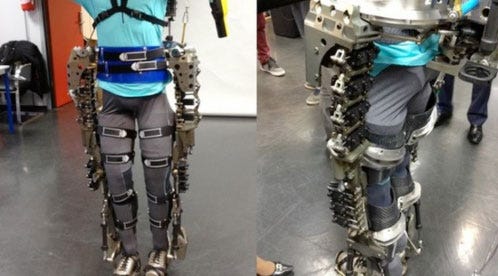World Cup to Open with Mind-Controlled Exoskeleton Kick
May 5, 2014
The Walk Again Project intends to put a paralyzed Brazilian volunteer into their mind-controlled exoskeleton. The plan is for the volunteer, using only thought, to use the suit to walk across the soccer field and make the ceremonial opening kick of the World Cup soccer tournament on June 12.
The Project is a nonprofit collaboration of several universities and a worldwide network of more than 100 scientists led by Miguel A. L. Nicolelis, MD, PhD, Department of Neurobiology, Duke University Medical Center, the Duke immersive Virtual Environment (DiVE) at Duke University is doing much of the heavy lifting behind the Project, which is intended as a showcase for recent advances in neurotechnology.
|
A prototype of Walk Again Project's mind-controlled exoskeleton (Courtesy The Walk Again Project) |
"We want to galvanize people's imaginations," Nicolelis told the Washington Post.
The suit consists of the pair of exoskeleton legs and a helmet to pick up the brain impulses of the wearer. The headpiece used on opening day in Brazil will be a noninvasive EEG device and the first of its kind.
"It's going to be like putting a man on the moon--it's conquering a level of audacity and innovation that the people outside Brazil aren't used to associating with Brazil," MIT Technology Review says that Nicolelis has told audiences. The kick, Nicolelis has said, "will inaugurate a new era of neuroscience, [that of] neuroengineering."
But Antonio Regalado, writing for MIT Technology Review, says the event is not without its skeptics. Those reality checkers contend that the demonstration is as much publicity stunt as science. They question whether it will illustrate any real degree of thought control, Regalado reports.
Regalado cites three other research groups that have recently published reports of EEG-controlled exoskeletons. So far, he says, none have managed to do much more than send a start or stop signal. They let the robotic harness do the rest of the work on a preset trajectory, with plenty of outside assistance in balancing.
"That suggests that the level of brain control could be disappointingly minimal, even if it's presented as a breakthrough on TV," Regalado wrote.
"What would happen if a gust of wind moved the ball by three centimeters right before the demo began?" asks Andrew Schwartz, a neuroprosthetics researcher at the University of Pittsburgh. "Everything you'll see in the demo will be fancy robotics, not brain control, and it will probably all be preprogrammed."
"We are well aware of the limitations of EEG, but we decided to show what could be done," Alan Rudolph, vice president for research at Colorado State University and manager of the project, told Regalado. "People will see a control system that is new in terms of using and exploiting brain signals as well as body signals."
Stephen Levy is a contributor to Qmed and MPMN.
About the Author(s)
You May Also Like



